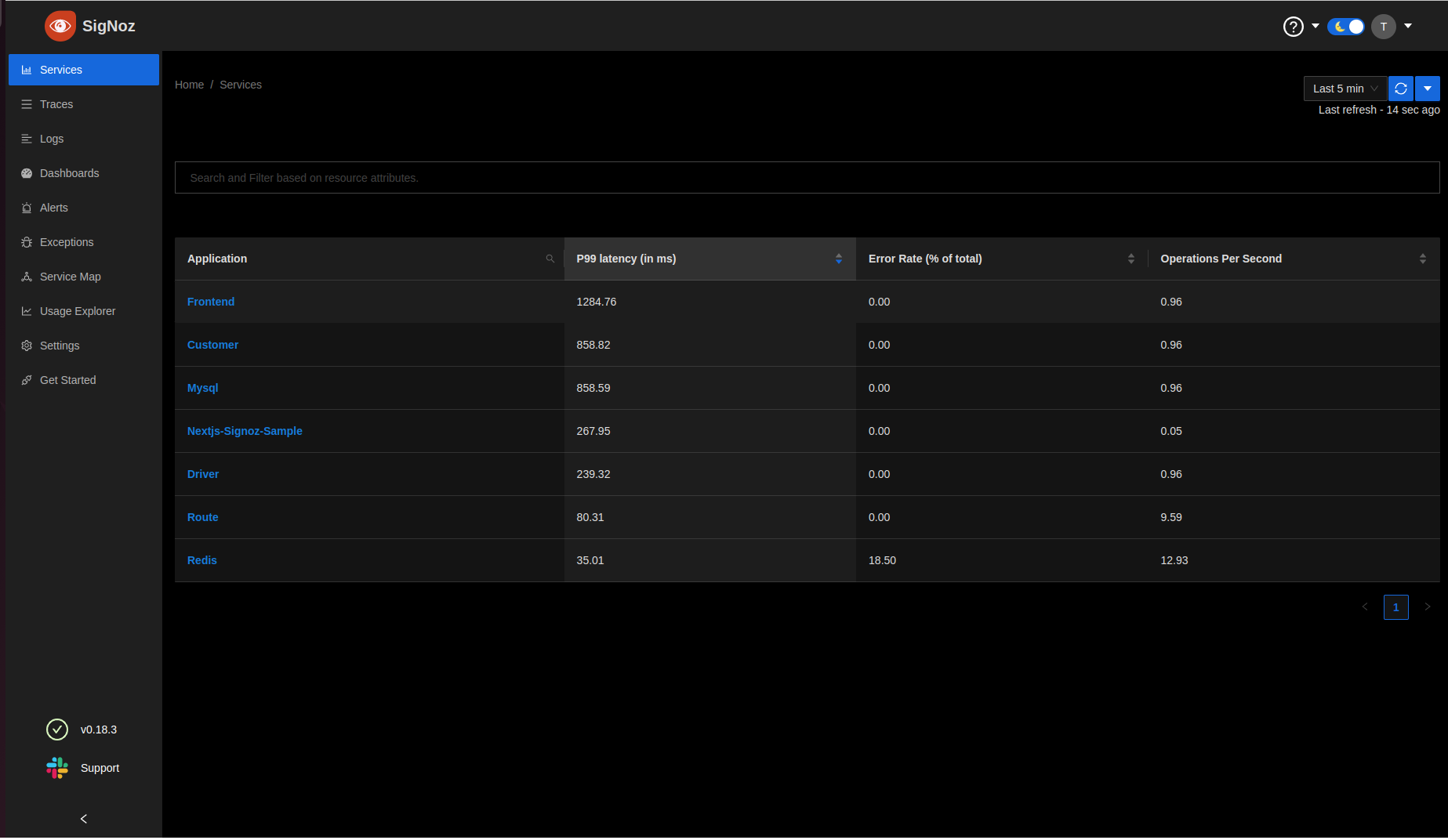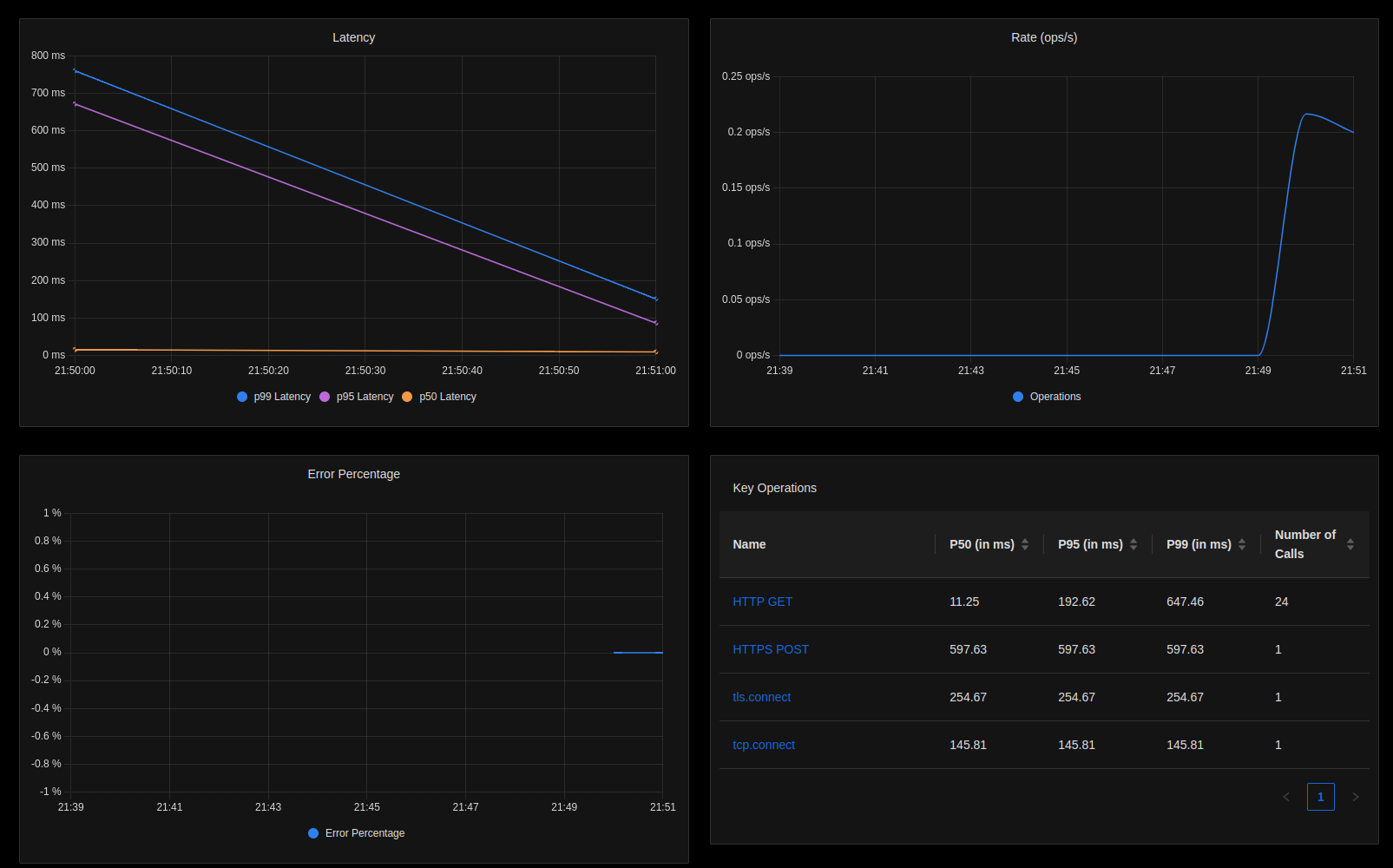Though Next.js has its own monitoring feature, it does not have end-to-end monitoring and no tracing of database calls this is when OpenTelemetry comes into the picture. Okay so we have the telemetry data but how and where do you analyze it? which is why you need Signoz.
OpenTelemetry and Signoz and how to install them?
OpenTelemetry
OpenTelemetry is a open-source project which was hosted by CNCF. It provides a standard way to generate telemetry data - data like logs, metrics, events and also traces which are all created by your applications.

It might not look all that useful when you started your application as a set of microservices, but as the usage of your application increases and time comes for you to scale up, keeping track of all the microservices, their bugs and other metrics becomes difficult. For all that you need OpenTelemetry, be it logs, metrics, or just traces OpenTelemetry provides a single standard for observability, you can store, visualize and query data with the help of SDKs, APIs and othertools.
OpenTelemetry can also:
- Provide support for both automatic and manual instrumentation.
- Provide end-to-end implementations to genrate, collect, emit, process and export telemetry data.
- Supports multiple context propagation formats parallelly.
- Provides a pluggable architecture so that other formats and protocols can be added easily.
NOTE: Opentelemetry does not provide back-end observability like Jaeger or Prometheus. Also, it only supports
server-side instrumentation.
Signoz
Signoz is an analysis tool for backend and it is also a full-stack open-source APM tool for all the data from OpenTelemetry. It helps in providing query and visualization capabilities for the end-user and allows you to keep track of your applications metrics and traces in one place. So, if you want to store and view metrics of the data collected by OpenTelemetry then you’ll have to install Signoz.
Signoz Installation
NOTE: Signoz is only supported in Linux and macOs machines. As of now Windows does not officially support Signoz.
Run the script below - this automatically installs Docker engine too on Linux but if you are on macOS you’ll have to install Docker seperately.
git clone -b main https://github.com/SigNoz/signoz.git
cd signoz/deploy/
./install.sh
Now that Signoz has been successfully installed on your local machine you can access it at http://localhost:3301
Before you install OpenTelemetry just run your Next.js application
Running your sample Next.js application
If you already have a next js application, uyou can run it using npm run dev if you need help with creating a Nextjs application you can refer to Next.js 101
. You should be seeing your Next.js app running on http://localhost:3000
OpenTelemetry Installation:
Step 1: Install packages
In your Next.js application install OpenTelemetry packages
npm install @opentelemetry/sdk-node
npm install @opentelemetry/auto-instrumentations-node
npm install @opentelemetry/exporter-trace-otlp-http
npm install @opentelemetry/resources
npm install @opentelemetry/semantic-conventions
Step 2: Create a tracing.js file
//reference: https://signoz.io/blog/opentelemetry-nextjs/
'use strict'
const opentelemetry = require('@opentelemetry/sdk-node');
const { getNodeAutoInstrumentations } = require('@opentelemetry/auto-instrumentations-node');
const { OTLPTraceExporter } = require('@opentelemetry/exporter-trace-otlp-http');
const { Resource } = require('@opentelemetry/resources');
const { SemanticResourceAttributes } = require('@opentelemetry/semantic-conventions');
// custom nextjs server
const { startServer } = require('./server');
// configure the SDK to export telemetry data to the console
// enable all auto-instrumentations from the meta package
const exporterOptions = {
url: 'http://localhost:4318/v1/traces',
}
const traceExporter = new OTLPTraceExporter(exporterOptions);
const sdk = new opentelemetry.NodeSDK({
resource: new Resource({
[SemanticResourceAttributes.SERVICE_NAME]: 'Nextjs-Signoz-Sample'
}),
traceExporter,
instrumentations: [getNodeAutoInstrumentations()]
});
// initialize the SDK and register with the OpenTelemetry API
// it allows the API to record telemetry
sdk.start()
// gracefully shut down the SDK on process exit
process.on('SIGTERM', () => {
sdk.shutdown()
.then(() => console.log('Tracing terminated'))
.catch((error) => console.log('Error terminating tracing', error))
.finally(() => process.exit(0));
});
module.exports = sdk
Step 3: Create a server.js file : this is the file that we imported into the tracing.js file
//reference: https://signoz.io/blog/opentelemetry-nextjs/
const { createServer } = require("http")
const { parse } = require("url")
const next = require("next")
const dev = process.env.NODE_ENV !== "production"
const app = next({ dev })
const handle = app.getRequestHandler()
module.exports = {
startServer: async function startServer() {
return app.prepare().then(() => {
createServer((req, res) => {
const parsedUrl = parse(req.url, true)
handle(req, res, parsedUrl)
}).listen(8080, (err) => {
if (err) throw err
console.log("> Ready on http://localhost:8080")
})
})
},
}
Step 4: To start your server now you have to add a script
To add script > Go to package.json > now add npm run start:server your package.json will look something like:
"scripts": {
"dev": "next dev",
"build": "next build",
"start:server": "node tracing.js",
"lint": "next lint"
}
For the final step run the server
Step 5: Run the server to monitor your application
Run npm run start:server, by default your application will be available on http://localhost:8080.
NOTE: If your port is already in use make sure you use a different port number or you can also kill the port.
# Use the following commands:
- sudo lsof -i:<portnumber>
- kill -9 <PID> where PID is your process id.
Now hit your URL a few times for dummy data and wait for your application name to be visible - you should already be seeing

Click on your applications name, here it will be Nextjs-Signoz-Sample to view the dashboard and monitor your applications metrics like latency, number of requests per second(rpc), percentage of error.

To visualize how user requests perform across services in a multi-service application you need tracing data captured by OpenTelemetry - Go to Traces tab in Signoz

Conclusion
We can see how OpenTelemetry can be used to instrument your Nextjs applications for end-to-end tracing and how you can use Signoz to keep track of the metrics collected by OpenTelemetry for the smooth performance of your application. For more detailed information you can look at the blog on Monitoring your Nextjs application using OpenTelemetry . They have a very detailed information on Signoz and OpenTelementry and multiple installation methods.
